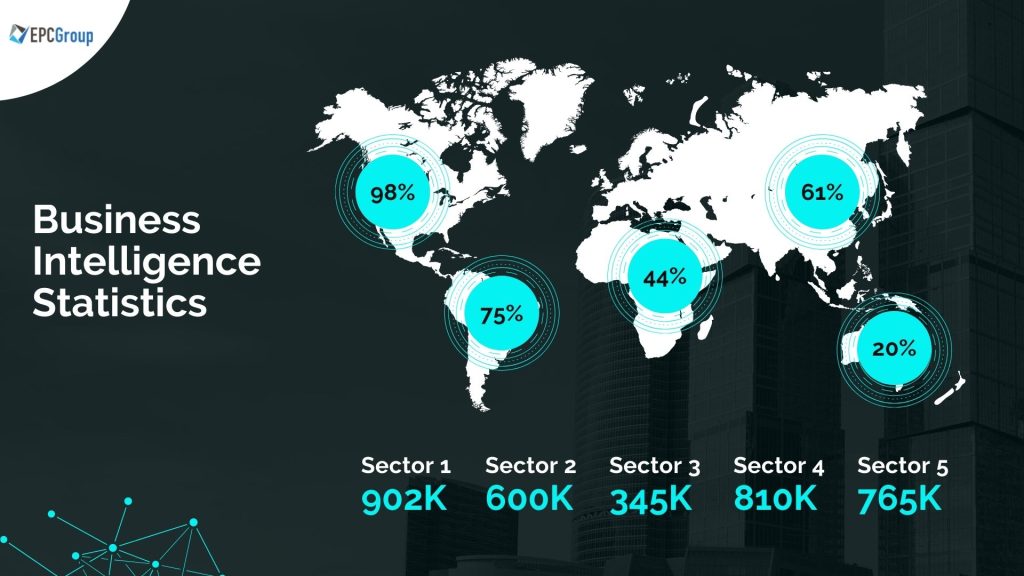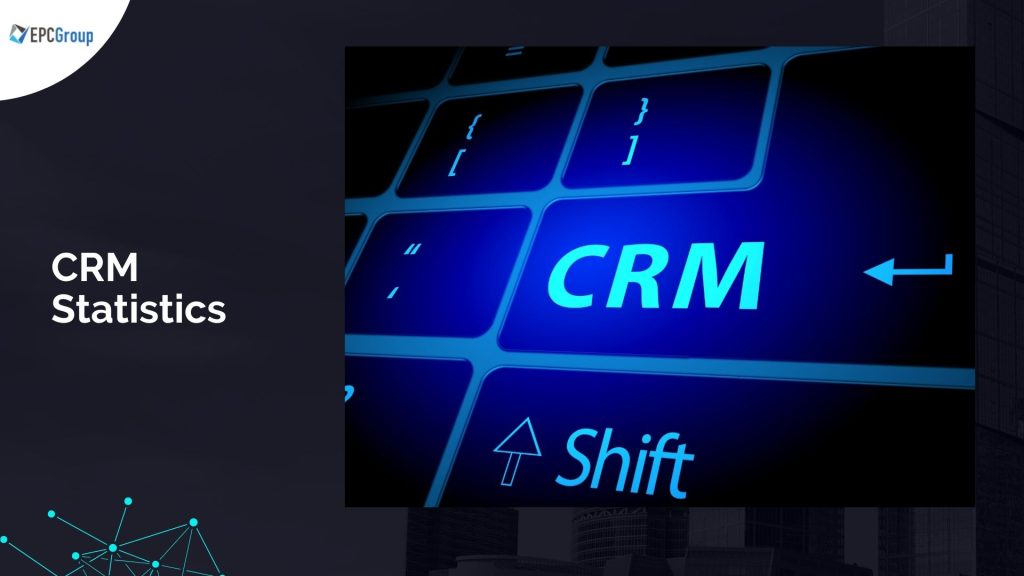Industry statistics and trends change each year, but the last year or so was provided with unique situations amidst the onset of the coronavirus pandemic. Companies were forced to create advanced and unique solutions in the face of all the challenges, which come with a remote world. The Business intelligence sector is no exception to that.
New trends and statistics started to pop up in the field of data analytics as organizations reoriented their strategies to reflect the odd situations. As we move forward from the crisis and look into the future, it is vital to keep a close eye on statistics and trends in the industry to better know where the market is moving forward in the new few years.
Business Intelligence Statistics and Trends For 2022
Most talked about Business Intelligence Statistics
1. Responsible AI takes the stage
Source: Harvard Business Review
Responsible AI helps accomplish fairness, although biases are backed up into the data: obtain trust, even though explainability and transparency methods are changing. It also guarantees regulatory compliance while grappling with the probabilistic nature of AI.
2. Shift to the cloud
Source: Gartner
Public cloud services would be needed for ninety percent of data and analytics advancement by 2022. Cloud computing is also advancing when it comes to flexibility, speed, and innovation.
3. There will be a rise in predictive analysis
Source: Facts and Factors
A survey published by Facts and Factors found out that the global analytics market is predicted to reach $22.1 billion by the end of 2026, increasing at a CAGR of at least 24.5 percent.
4. Embedded analytics
Source: Allied Market Research Report
The global embedded analytics market has been anticipated to reach $60 billion by 2023, allowing speedy data analysis without any date movement from one software environment to another.
5. AI incorporation in mainstream BI
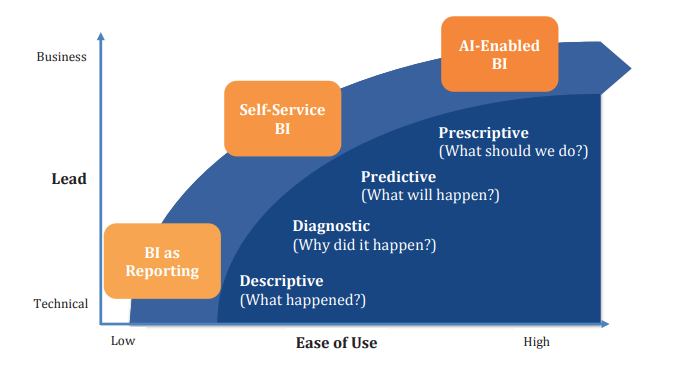
Source: IBM
BI and analytics are taking shape in the age of automation. Intelligent computer systems are destined to change human workers in different sectors—that is already happening in manufacturing, healthcare, and financial services.
6. Storytelling through data
Source: The Presentation Company
Existing BI platforms involve storytelling and innovative data storytelling, allowing information to transform into a captivating story. A blog post from the Presentation Company compares data visualization along with data storytelling.
7. Mobile-friendly BI
Source: Mordor Intelligence
The mobile market will go beyond $20 billion by 2024. Mobile devices such as tablets and smartphones are expected to comprise over seventy-two percent of online traffic.
8. NLP-run BI
Source: Tech Target
NLP removes the need for a translator between machine language and human language. BI vendors in the past years have incorporated NLP in their solutions. NLP has changed as a core communication tool in analytics and BI solutions since 2020.
9. Automation in BI and analytics
Source: Outlier.ai
Automation is vital for big-scale analytics projects, where manual labor will result in wasted efforts and inefficiencies. In 2020, sixty-four percent of big companies utilized AI to automate data analysis, which is a massive increase from the 2019 figure of fifty-five percent. Outlier.ai explains how AI-run BI could help unleash real-time patterns and insights.
10. AI for sustainability
Source: Earth.org
Artificial intelligence could help the globe in accomplishing ninety-three percent of the environmental sustainability goals determined by the United Nations.
Business Intelligence Statistics as per industry
11. Telehealth is here to stay
Source: McKinsey
The number of patients using telehealth will grow from 11 to 46% in 2020, with growth likely to continue. It is predicted that telehealth could account for twenty percent or $250 billion of US healthcare spending in the future.
12. Data analytics to strengthen biotechnology innovation
Source: Harvard Business Review
Medical professionals are leveraging machine learning algorithms to evaluate why specific drugs are efficient. That can help inform future development efforts. Data analytics also hold promise for predictive medicine, taking advantage of AI to assess tests and medical records.
13. AI lowers healthcare-associated infections
Source: Wolters Kluwer
In 2022, hospitals will be looking more closely than ever at the efficacy of infection prevention and control programs run by AI to better monitor patients in real-time with fast infection risk identification.
14. Unstructured health data helps medical experts and researchers create health equity
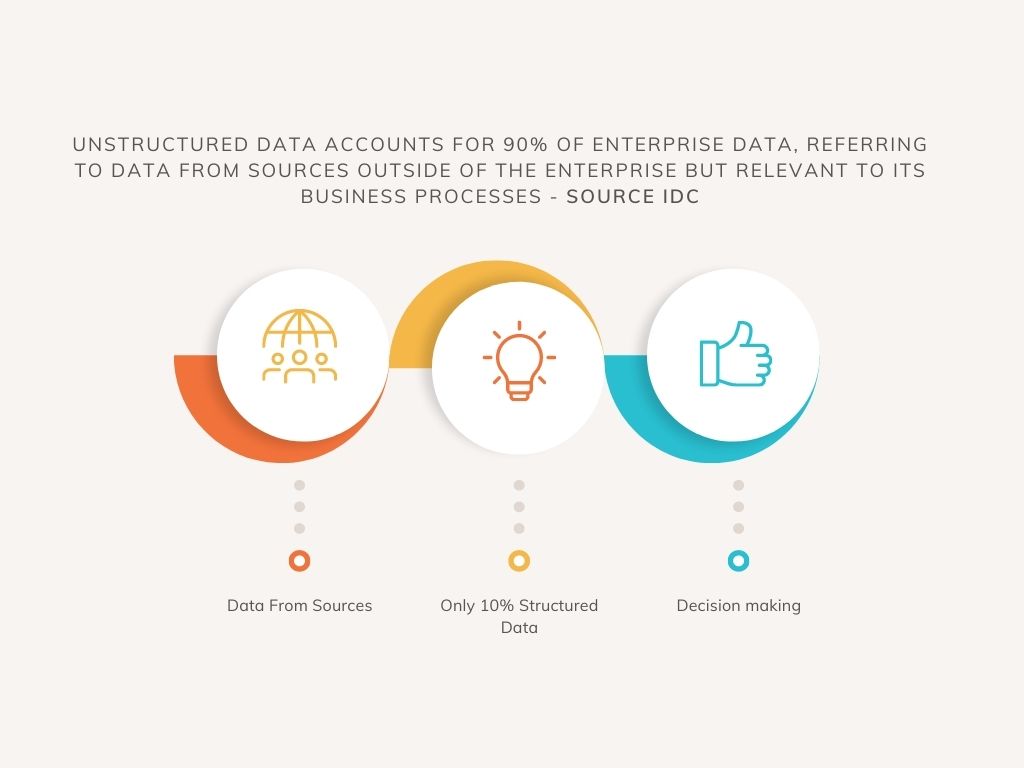
Source: Hospital & Healthcare Management
Machine learning tools like text mining and natural language can support health systems show important health-equity insights hidden in unstructured clinical data that is hard to store, search, evaluate, and share across health systems.
2022 will become a crucial year for making healthcare data help and not delay the bigger goal of providing the best care anywhere.
15. Data from wearables will start to play a role in patient care
Source: CDC
If executed based on science, mobile health technology can significantly empower people to be engaged participants in their care and more accountable for their health while enhancing preventive medicine, helping save lives.
16. Accelerated cloud adoption and SaaS
Source: Dresner
The demand for cloud BI continues to increase in a huge space. Ninety-five percent of enterprise software vendors consider it essential, and fifty-four percent say it is either important or critical to their business initiatives.
17. AI will become the new BI
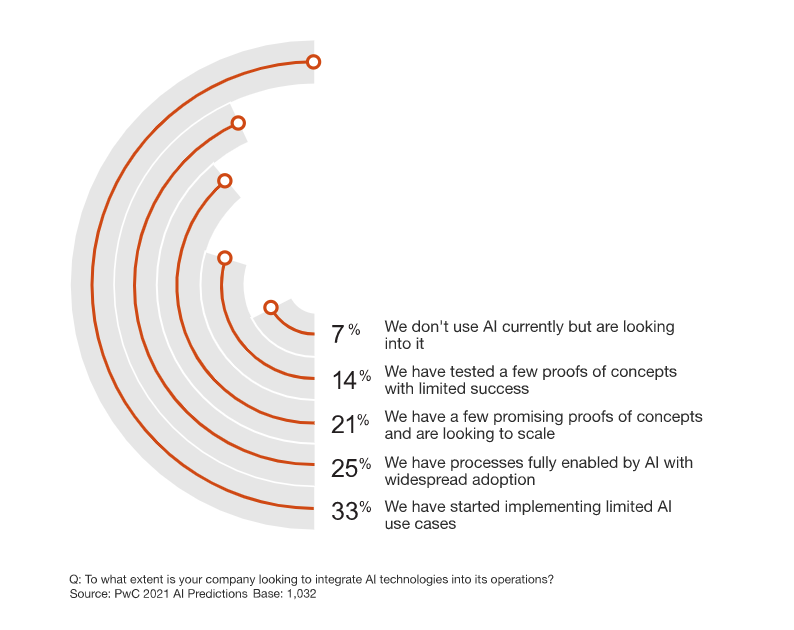
Source: PWC
Organizations across America are ramping up their artificial intelligence investments in a post-coronavirus world, along with the ramifications certain to reflect in the future. Eighty-six percent of executives said that AI would become a mainstream technology at their company.
18. Self-service BI is considered self-sufficiency
Source: Business Application Research Cente
Self-service BI encourages users of every technical skill level to access and use data efficiently. It lightens workloads and demands on IT staff, as a user can assess and sort data by themselves by producing ad-hoc reports without requesting and waiting for reports from another team.
19. BI will help produce more bespoke customer shopping experiences
Source: McKinsey
With BI, ground floor employees can create more immersive experiences for every individual customer.
20. BI help control costs in the construction industry
Source: Constructible
Manage costs and inventory in each process—from bidding to the building—so every project can be monitored by region, supplier, job, or whatever yields the greatest business value.
Business Intelligence growth in 2021 and forecast for growth in 2022
21. The global business intelligence market will be valued at $30.9 billion by 2022
Source: Beroe, Inc.
The key drivers behind the forecasted trend include demand for DaaS, big data analytics, demand for personalized, self-servicing BI capabilities.
22. The annual growth rate for BI is 8.5 percent
Source: Fortune Business Insights
It was studied that the global market size for business intelligence is $20.60 billion in 2019 and is anticipated to reach $39.35 billion by 2027.
23. BI market to be valued at $30.9 billion by 2022
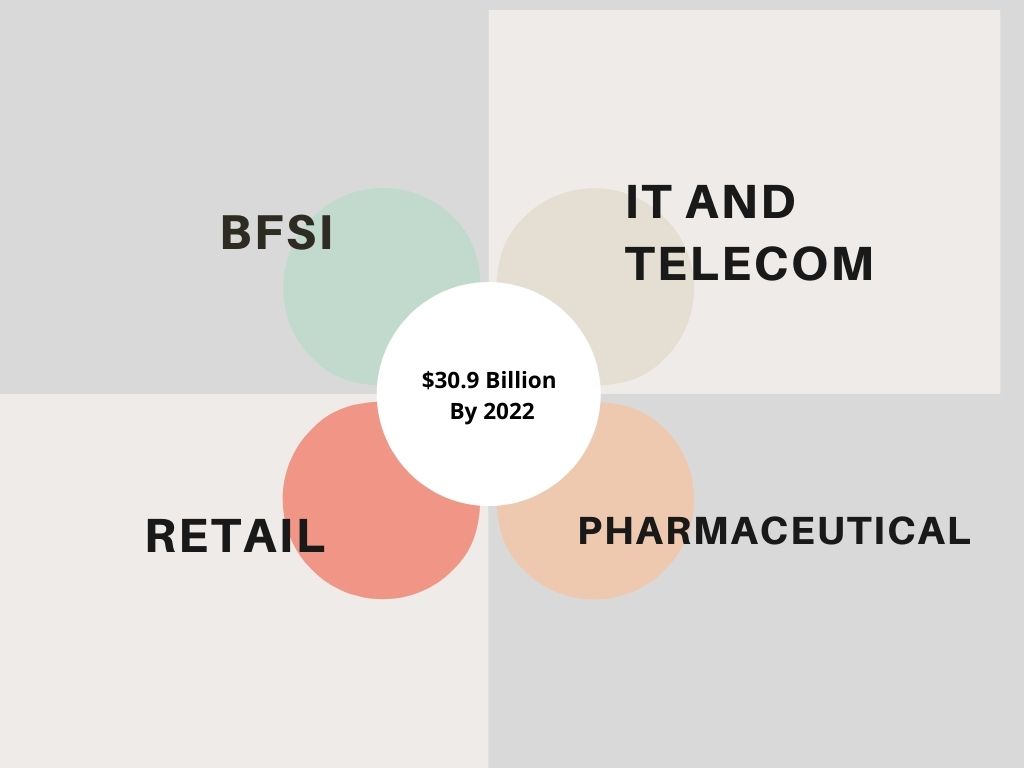
Source: BEROE Inc.
There’s a growing need for big data analytics as each day, the amount of big data creation accounts for 2.4 quintillion bytes.
24. There are four countries with high market maturity of BI
Source: BEROE Inc.
High market maturity regions in Business Intelligence are Australia, Japan, Germany, the United Kingdom, and the United States. On the other hand, Canada, China, India, and Brazil are medium market maturity regions.
25. The AI market will reach a record-breaking high in implementation and usage
Source: Aretove
The AI industry is anticipated to increase at an annual compound rate of over 33% until the year 2028. That value is anticipated to grow due to the substantial adoption rate by big-scale companies.
26. Global big data analytics in retail estimated to increase to $25.56 billion
Source: Allied Market Research
By 2028, global big data analytics in the retail market is estimated to grow to $25.56 billion, along with a CAGR of 23.1% from 2021 to 2028.
27. By 2023, 33% of big-scale companies will adopt decision intelligence
Source: Information Week
Trends for 2021 demonstrate that one of three organizations will be utilizing decision intelligence in the future.
28. The cloud-based BI market is the fastest-growing BI sector
Source: MarketsandMarkets
The fastest-growing segment sector is cloud analytics that is anticipated to increase at a CAGR of 23.0%, expanding from $23.2 billion in 2020 to $65.4 billion by 2025.
29. The mobile BI market could increase at least $16 billion by 2023
Source: Nix Solutions
Mobile BI is growing fast, and it’s projected to increase its value from $4.1 billion in 2016 to $16 billion in 2023.
30. The worldwide BI and analytics software market is predicted to reach $420,98 billion in 2027
Source: Allied Market Research
When combined with big data, the global BI and analytics software market are projected to reach that number by 20227. It is growing at a predicted CAGR of 10.9 percent from 2020 to 2027.
Business Intelligence Statistics around Jobs
31. More data scientist jobs are needed
Source: Data Flair
Around 11.5 million data scientist jobs will be done by 2026, according to the US Bureau of Labor Statistics.
32. Data science jobs are needed in finance and insurance
Source: Forbes
Five percent of all data science and analytics job demands can be found in insurance and finance, professional services, and IT.
33. There’s a data science talent shortage
Source: QuantHub
As of 2020, America has a shortage of 250,000 individuals with analytical data skills.
34. The need for data engineers will increase by 50% per year
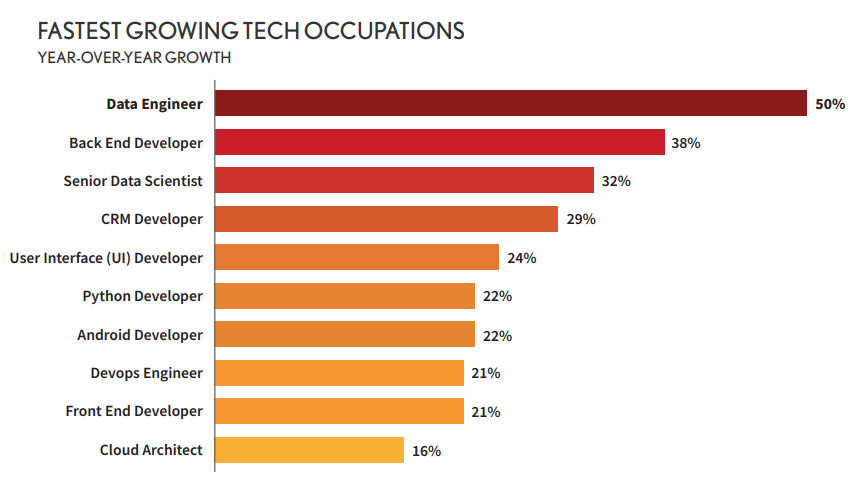
Source: DICE
The demand for data engineers is anticipated to increase at a rate of fifty percent per year. The report noted that Capital One, Accenture, and Amazon are hiring data engineers at a high rate.
35. Executive management, finance, and operations drive BI adoption
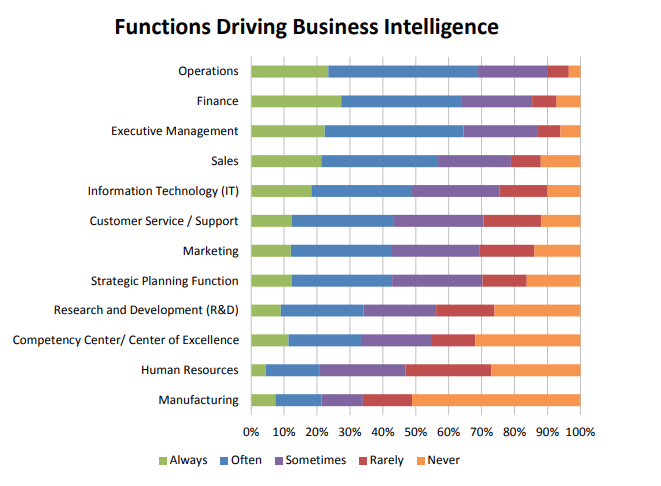
Source: Dresner
In 2020, the top three functions that drive business intelligence adoption were operations, finance, and executive management.
36. 52% of organizations use BU
Source: TechCrunch
Fifty-two percent of software companies and fifty percent of finance companies utilize business intelligence and analytics to determine new revenue streams that are key to advancing and growing their business.
37. Business analysts are in huge demand
Source: ASU Online
Demand for people in business analytics roles is growing because of the impact big data has on the worldwide economy. The US BLS predicts there will be 1.5 million jobs in the field by 2018.
38. There are at least 104,208 BI analysts in America
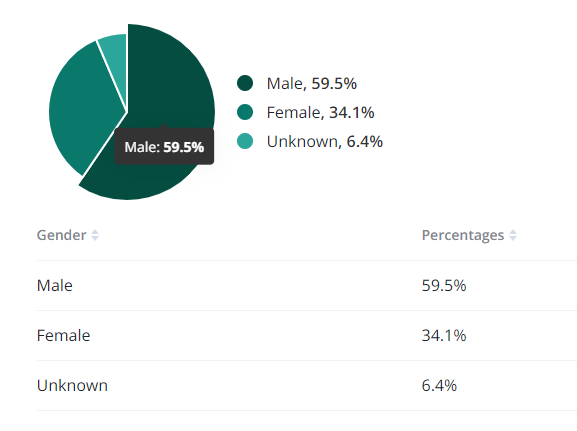
Source: Zippia
There are more than 104,208 BI analysts currently employed in America. 34.1 percent of them are women, while 59.5% are men. The median age of employed BI analysts is 43 years old.
39. Average salaries of data engineering increased to seven percent
Source: QuantHub
Many studies show that data engineers are the highest-paid talent and that salaries remain to increase. Average salaries for these roles increased by seven percent in NY and six percent in Bay Area.
40. Twenty-five percent of new workers feel confident in using organizational data
Source: Accenture
It was found out that just a quarter of new workers feel that they receive proper and enough coaching when it comes to data use during their onboarding.
Business Intelligence Statistics around profit gained by organizations
41. BI software vendors obtained a total revenue of nearly $14.9 billion
Source: Apps Run the World
Nearly 62.5% of the BI analytics and software market globally was managed by the top ten BI software providers. They had a combined revenue of at least $14.9 billion.
42. Hospitality and telecommunications put the highest importance on analytics
Source: MicroStrategy
Based on a research of companies and businesses with $100 million or more in annual revenue, the industries that put the highest importance on mobile business analytics platforms and applications are telecommunications with 56% and hospitality with 58 percent.
43. Business intelligence will grow more
Source: Reuters
Gartner predicted the global revenue of business intelligence to grow to $22.8 billion in 2021. On the other hand, Reuters predict added growth to $29.48 billion by 2022. The BI market is booming and will continue to do so.
44. Banking accounts for 13.9% of revenue for the BI market
Source: Your Story
The banking sector accounted for approximately $204 million in revenue. Forty percent of all organizations assert business intelligence to be very important or important in their business activities. The main driving factors behind the market are growing accessibility, continuously enhancing benefits for users, and innovating technology.
45. Technology, financial and retail services to increase their BI budgets
Source: Business Intelligence Market
The said organizations are the leading industries increasing their investment in BI. Each of these is planning to raise their budgets for BI by more than fifty percent.
46. The global big data analytics in retail produced $4.85 billion in 2020
Source: Allied Market Research
Retail is investing in data. The increase in big data analytics tools, the need to offer bespoke customer experience to boost sales, and the growth of e-commerce contribute to that growth.
47. America will be the highest business intelligence generator in 2021
Source: Statista
The United States produced $11,727 million in 2021, according to BI adoption statistics. Thus, the nation became the largest earner from technology globally.
48. Power BI is currently the leading BI software in the globe
Source: Zerabi
The revenue of the software was $30.1 billion and increased by seventeen percent. Its operating income was $10.4 billion and increased thirty-five percent. Their net income was $8.9 billion GAAP and $8.8 billion non-GAAP.
49. Small businesses use business intelligence tools
Source: Grand View Research
Over forty-six percent of small businesses utilize the virtual networking features of BI tools as a core element of their overall business strategy.
50. Global companies are increasing their investments in AI and big data
Source: NewVantage Partners
91.6 percent of worldwide companies in 2019 increased their investments in AI and big data. In 2020, the pace of their investment had leveled off, with 51.9 percent of companies increasing their rate of investment.
Sources:
Harvard Business Review Gartner Facts and Factors Allied Market Research Report IBM The Presentation Company Mordor Intelligence Tech Target Outlier.ai Earth.org McKinsey Harvard Business Review Wolters Kluwer Hospital & Healthcare Management CDC Dresner PWC McKinsey Constructible Beroe, Inc. Fortune Business Insights BEROE Inc. Aretove Allied Market Research Information Week MarketsandMarkets Nix Solutions Allied Market Research Data Flair Forbes QuantHub DICE Dresner TechCrunch ASU Online Zippia QuantHub Apps Run the World MicroStrategy Reuters Your Story Business Intelligence Market Allied Market Research Statista Zerabi Grand View Research NewVantage Partners


